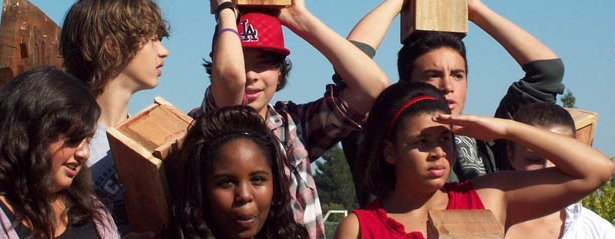Waldorf News
A Modern American Fairy Tale

The numbers of state subsidised and state funded Waldorf schools are rapidly rising in the USA. In the past, the association of privately-financed Waldorf schools has tended to view this model with some scepticism. Martyn Rawson reports about current developments. -Erziehungskunst (Art of Education)
Three tenth grade pupils are walking about the school playground. One of them has her eyes covered and the other two are moving around her clapping their hands. The senses have just been dealt with in main lesson and the three of them are experimenting with using their hearing for orientation. What is special about this scene is the fact that they dare to move about the playground alone with their covered eyes. A few years ago that would have been impossible in this school. Violence, bullying and drug dealing were part of everyday life in the school playground. Large musclemen with loud voices, security guards, called after pupils: “Git inta class!” and ensured that they hurried as quickly as possible from one class to the next so that they did not have time for illegal activities.
 The school described here was one of the worst schools in California. It was, as principal Allegra Allessandri said, a failed school. In the meantime the George Washington Carver School of Arts and Science, a “Waldorf-inspired High School”, wins prizes for the quality of its learning and the school’s performance as a whole. An exhibition in the foyer presents pupil projects of impressive quality on the theme of poverty in the district of Sacramento in which the school lies.
The school described here was one of the worst schools in California. It was, as principal Allegra Allessandri said, a failed school. In the meantime the George Washington Carver School of Arts and Science, a “Waldorf-inspired High School”, wins prizes for the quality of its learning and the school’s performance as a whole. An exhibition in the foyer presents pupil projects of impressive quality on the theme of poverty in the district of Sacramento in which the school lies.
I visited a ninth grade which was just rehearsing a play. It was an adaptation of a fairy tale by the Brothers Grimm. A tower of tattooed boys of various origins represents a tree, below that pupils were skipping with a rope. The girls had plenty of makeup on, wore miniskirts and were attempting to jump over the swinging rope.
In twelfth grade I was able to observe a discussion about symptomatology in cultural history. A lively debate was going on about the idea of reality in the Middle Ages. Another class was composing a sonnet with a precise number of syllables and rhymes.
The school has been transformed in the last six years under the dynamic leadership of Ms Allessandri, herself a former Waldorf pupil and teacher. With the help of experienced Waldorf colleagues, she introduced the methods and curriculum of Waldorf education. Since then the school playground has developed into a place of recuperation, peace and meaningful activity – a school garden was also created which provides fresh produce each day. One boy, who until then was deemed to be too difficult to educate and not far off a criminal career, builds beautiful wooden benches and looks after the playground.
The story in Carver is a true fairy tale of modern America. There are, however, also restrictions. All the teachers have to be members of the teaching trade union which prevents them from giving continuous main lessons. Teaching is restricted by the trade union in order to protect teachers because of the high number of teaching hours and the great stress associated with teaching – both normal in schools. One benefit of this situation is that teachers are well paid and, very important in the USA, benefit from good welfare provision – and certainly significantly better than for Waldorf teachers in the independent Waldorf schools.
The curriculum and teaching in Carver, as in the other schools I visited, can be placed within the spectrum of a normal Waldorf school, in small towns to the same extent as in city schools. Parents do not have to pay school fees. The school fees in private Waldorf schools range between 17,000 and 28,000 dollars per year for each pupil. Many Waldorf teachers (also in public Waldorf elementary schools) cannot afford to send their own children to a private Waldorf high school. In a country like the USA, education reflects the social structures pretty accurately. Private schools simply cater for a different clientele, namely families from the higher social classes. Charter and public schools, in contrast, serve the people who live in the vicinity of the school. That gives rise to quite different tasks.
 Private or public – the current divide
Private or public – the current divide
The number of Waldorf schools with a public mandate and public funding (charter schools) or state schools with a Waldorf profile (Waldorf public schools) is steadily growing. There are meanwhile 52 public and charter Waldorf schools in the USA. In 1990 it was three, of which two have meanwhile ceased to exist. Another five schools have been added to the tally this year. 44 of these schools are members of the Alliance for Public Waldorf Education (APWE).
It continues to be a controversial subject whether or not these schools should be allowed to use the designation Waldorf. None of them are on the world list of Waldorf schools. The Association of Waldorf Schools of North America (AWSNA), the association for private Waldorf schools, refuses to recognize them. The German Association of Waldorf Schools only recently reaffirmed that AWSNA alone had the name rights to “Waldorf” and “Steiner” in North America. Thus AWSNA determines which schools may call themselves Waldorf and which may not. So far AWSNA has taken the view that Waldorf schools should not be allowed to receive money from the state because that would restrict their autonomy. According to this criterion, most Waldorf schools in Europe, including Germany, in Australia and New Zealand would not be proper Waldorf schools either because they receive state funding.
Private and public Waldorf schools in dialogue
Two years ago Will Stapp, the tireless president of APWE, and Patrice Maynard, chair of AWSNA, were in my working group in Dornach during the world teachers’ conference. We fell into conversation. The result was the invitation for me to visit the USA. Meanwhile the leadership of AWSNA is engaged in constructive dialogue with the Alliance. At a local level, the relations between private and public Waldorf schools appear to be collegial and friendly, certainly in California and the south-west of the USA, something which will make an approach at association level easier. The caution on both sides is understandable since there are real differences and tensions between the private and public Waldorf schools which are not easy to overcome. But their common educational interests are more important.
Teacher training situation
Both associations are already working together in teacher training. The Rudolf Steiner College in Sacramento has set up an accredited Masters program for teachers in the public and charter schools. The lecturers are experienced Waldorf colleagues. Betty Staley, for example, has been a Waldorf teacher for over 50 years and is the author of a classic in Waldorf literature on adolescent education. The program can partly be completed online with the use of webinars (Internet seminars) as the students are spread across the whole continent including Alaska and Hawaii. Many of the students who will in future work in public and charter schools learn in other training centers where they meanwhile make up the larger part of the student body.
What constitutes Waldorf?
I visited a total of eight public Waldorf schools in California. Class visits and conversations with teachers left me with the impression that these schools do indeed practice Waldorf. Are these schools really Waldorf? And what ultimately constitutes Waldorf? I have visited Waldorf schools in many countries and believe I can recognize what constitutes Waldorf quality and the essence of Waldorf. I do not share the view that fulfilling the Waldorf curriculum, traditional forms of self-administration or externalities such as a hand-carved wooden sign are the essential criteria. As someone who concerns himself a lot internationally with the Waldorf curriculum, I see too much culturally-determined content and have too many question concerning the archetypal image of child and adolescent development. A working group in the Pedagogical Section at the Goetheanum is working on Waldorf essentials which will shortly be published. Only then will we have a basis for making a judgement on what really constitutes a Waldorf school.
Schools with principals
Charter and public Waldorf schools have to accept all children who register and give them an education. They also have school principals who have to exercise clear leadership tasks. Without such leading personalities, schools such as Carver would hardly be able to manage their tasks in the available time. All schools which I visited endeavor to develop their education on a collegiate basis but are led as a rule both educationally and administratively by experienced Waldorf teachers. I must admit in all honesty that I was a little jealous when I met these school principals and experienced their passion and professionalism in the endeavor to assure the highest quality of Waldorf teaching in their schools.
About the author: Martyn Rawson has been a Waldorf teacher in schools in England and Germany since 1979. He is the author of several books about Waldorf and co-editor of the English-language curriculum which has meanwhile been translated into 18 languages. From 1996 to 2010 he worked in the collegium of the Pedagogical Section in Dornach. Today he teaches at the Elmshorn Free Waldorf School and the Kiel Teacher Training Seminar.
Learn more about the Alliance for Public Waldorf Education here. Learn more about AWSNA here.
Many thanks to Erziehungskunst for permission to share this article with you. This article originally appeared at www.erziehungskunst.de, the online portal of the journal Erziehungskunst, which is published by the Association of Waldorf Schools in Germany. To see the article at source, just click here.
 Apply Today: New Cohort Starts Nov. 2025
Apply Today: New Cohort Starts Nov. 2025 Caring for All Stages of Life
Caring for All Stages of Life Quality Education in the Heartland
Quality Education in the Heartland Roadmap to Literacy Books & Courses
Roadmap to Literacy Books & Courses Full-Time Teacher Education
Full-Time Teacher Education Bringing Love to Learning for a Lifetime
Bringing Love to Learning for a Lifetime Transforming Voices Worldwide
Transforming Voices Worldwide Jamie York Books, Resources, Workshops
Jamie York Books, Resources, Workshops Association for a Healing Education
Association for a Healing Education Waldorf-inspired Homeschool Curriculum
Waldorf-inspired Homeschool Curriculum The Journey is Everything
The Journey is Everything Everything a Teacher Needs
Everything a Teacher Needs Immersive Academics and Arts
Immersive Academics and Arts
 Train to Teach in Seattle
Train to Teach in Seattle Flexible preparation for your new grade
Flexible preparation for your new grade ~ Ensoul Your World With Color ~
~ Ensoul Your World With Color ~ Bay Area Teacher Training
Bay Area Teacher Training Middle School Science With Roberto Trostli
Middle School Science With Roberto Trostli Space speaks. Its language is movement.
Space speaks. Its language is movement. Summer Programs - Culminating Class Trips
Summer Programs - Culminating Class Trips Waldorf Training in Australia
Waldorf Training in Australia Great books for Waldorf Teachers & Families
Great books for Waldorf Teachers & Families
 RSS Feeds
RSS Feeds